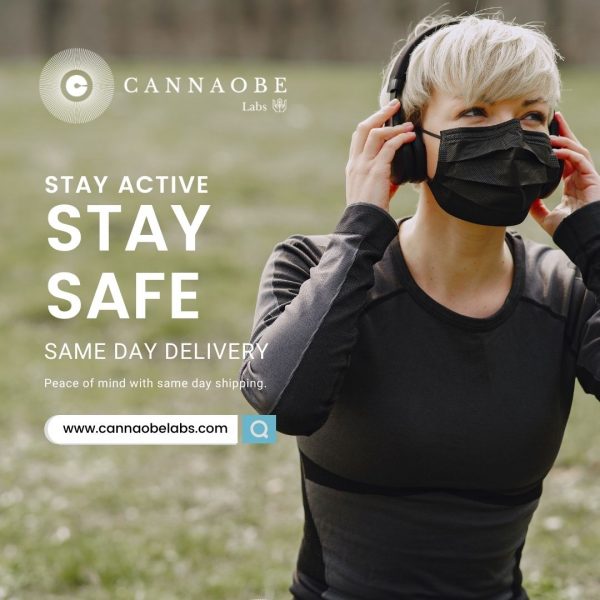WHETHER YOU’RE ROLLING THE YOUR YOGA MAT OR PUMPING IRON; BEFORE YOU GET BACK TO THE GRIND AT THE GYM, ITS CRITICAL TO CONSIDER A VARIETY OF FACTORS TO MITIGATE TRANSMISSION – HERE’S WHAT THE EXPERTS SAY.
The COVID-19 pandemic lodged a wrench in each of our professional and daily routines. With mandates preventing business like salons, restaurants, group training centers, and gyms; we were forced to find resolve for our quarantine-cabin fever in ways we never expected. For many the need to delay their workouts was more grueling than the exercises they sought. A number of dedicated social distancers found catharsis through virtual yoga sessions, others followed cardio exercises on youtube while their pets watched with their heads tilted, almost as confused as their owners.. Needless, to say there are many that are eager to return to their regular gym routines. As more and more states begin to reopen public recreation facilities it is crucial to stay conscious of possible transmission. With proper care and preparation it is possible to safely and responsibly workout in public.
Most states have allowed their gym’s to reopen with restrictions. One of the last states to keep their gyms shutdown during the pandemic is New York. However Governor Andrew Cuomo announced that gyms there could see a shift in regulations as early as Monday with new safety protocols, such as mandatory masks, reduced capacity and updated ventilation systems. The steps Gov. Cuomo has taken to mitigate the spread of COVID-19 have proven to be effective. Additionally, gyms are adding sanitation stations while patrons are encouraged to take advantage of personal sanitizing wipes which are invaluable in such environments. All precautions should be taken.
“If it’s not done right, it can be a problem and we’ve seen that,” – Andrew Cuomo
Dr. Brooks Gump, Epidemiologist and professor of public health at Syracuse University agrees gyms can be an issue: “Indoor exercise is not wise,” Dr. Gump stated during a conversation on CNBC Make It, “Even with regulations, the safest way to exercise is still outdoors wearing a face mask or inside your own home.”
Before making your way back into the gym you should consider various factors such as the COVID-19 positivity rate in your community. Gump continued, “…in places like Florida, where there’s a very high positivity rate of about 14%, you shouldn’t go to the gym, he says. New York’s positivity rate, on the other hand, is currently less than 1%, which means it’s likely safer.”
It is important to ensure gym staff and other patrons are actually complying with proper safety protocol. One of the most effective ways to keep your area clean is to use personal sanitizing wipes. G&Y Antibacterial Wet Wipes provide easy and practical packaging allowing you to keep you moving while safely sanitizing equipment. Also stay aware; Are patrons and employees wearing masks, is equipment appropriately spaced out and are the machines being cleaned, for instance? “If not, just avoid that gym,” he says. After completing workouts or any public outing, wipe down surfaces with sanitizing wipes in your car before you begin driving, Janitex wipes allow for multipurpose use, making them a great solution for cleaning your cell phone and other objects you may have handled while in the building.
Additional factors such as the type of workout you do and equipment used could also impact your risk of transmission. Gump adds, “There’s not a lot of data that compares different types of exercise, but we can make estimations based on how the virus is transmitted. Look at all those other factors before trying to think that you can control transmission by doing a weightlifting regiment instead of running,”
Here’s what experts want you to know about common gym workouts:
Yoga
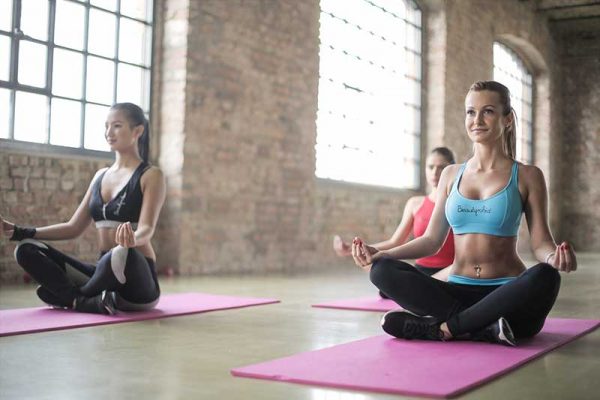 Yoga sessions often involve deep-breathing, which brings about more respiratory droplets than breathing at a regular pace, says Charlotte Baker, assistant professor of epidemiology in public health at Virginia Tech. A number of yoga classes are practiced in studios, which means several people’s respiratory droplets will be confined to the enclosed space. Researchers in South Korea found that “the lower intensity of Pilates and yoga did not cause the same transmission effects as those of the more intense fitness dance classes.”
Yoga sessions often involve deep-breathing, which brings about more respiratory droplets than breathing at a regular pace, says Charlotte Baker, assistant professor of epidemiology in public health at Virginia Tech. A number of yoga classes are practiced in studios, which means several people’s respiratory droplets will be confined to the enclosed space. Researchers in South Korea found that “the lower intensity of Pilates and yoga did not cause the same transmission effects as those of the more intense fitness dance classes.”
Experts Say: “Still wear a mask during yoga,” even with the deep-breathing, Baker says. Opening windows is one way to introduce more airflow in a room, she adds. Mats should also be positioned with at least six feet of distance from one another, and wiped with a disinfectant before and after use. Of course, practicing yoga outdoors would be the safest option, but it may not be feasible given the weather, Gump says.
Cardio machines
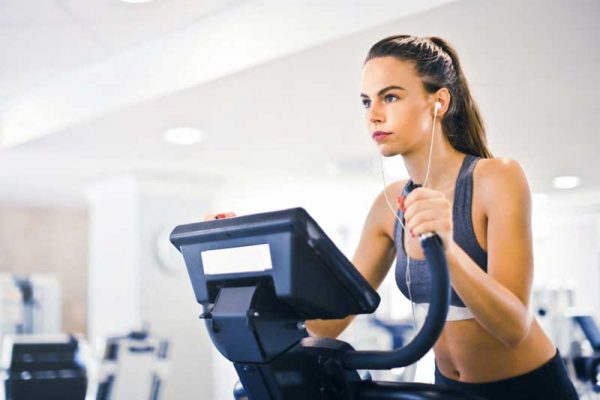
Many individuals visit their local gyms to use cardio equipment exclusively. Jumping on a treadmill or elliptical, is “a difficult exercise to manage,” because you tend to breathe heavily, Gump says. If a person is infected with COVID-19 and they’re doing cardio exercise in a gym, they’re potentially adding a lot of viral load to the ambient air around them.”
Experts Say: Machines should be adequately spread out or taped off so people can maintain physical distance of at least six feet, and cleaned after every use, Baker says. Wearing a NIOSH certified facemask, is key, she says. Although it may make it slightly more difficult to breathe, a mask will not interfere with your exercise performance or impact your oxygen intake.
Weight Lifting
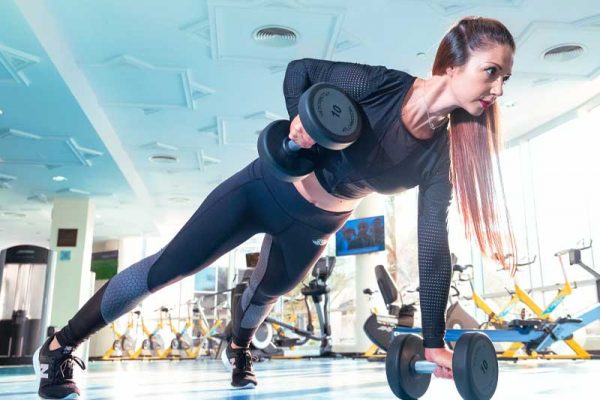
The variety of exercises that require lifting weights makes these routines a bit more difficult to manage when it comes to keeping safe. Weight rooms can get crowded, equipment might be located in a high-traffic area of the gym. For these reason, Free weights and resistance machines are considered “high-touch” objects. There are multiple surfaces that can be laborious to clean. “A lot of gyms have actually put in place a person who, that’s their whole job right now, is to go through and make sure that’s getting cleaned,” Baker says. With roles such as the position Baker mentions, Gym management teams can help their patrons feel safer.
Experts Say: Some gyms have moved free weights and equipment to basketball courts or even outdoor space to allow for more social distancing, Baker says. Avoid touching your eyes, nose or mouth when handling equipment such as weights. (Wearing lifting gloves may deter you from touching your face, but it’s not a replacement for hand hygiene.) Wipe any surfaces you touch, and then wash your hands with soap and water or use hand sanitizer after handling any shared equipment, according to the CDC.
Weight Lifting
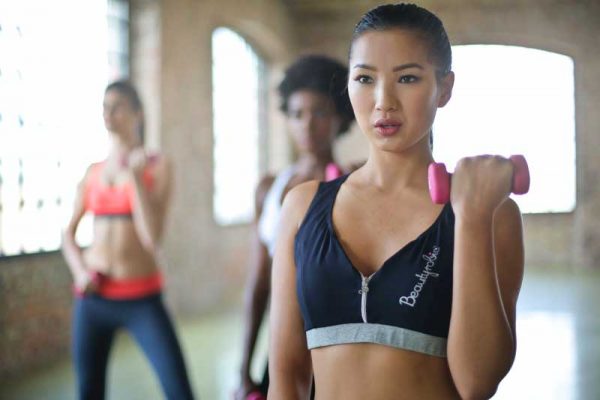
The study out of South Korea traced a cluster of 112 COVID positive cases back to group fitness classes, specifically dance cardio workouts. Researchers hypothesized that the population of large classes in small spaces complimented with the intensity of the workouts contributed to the extent of the spread.
“The moist, warm atmosphere in a sports facility coupled with turbulent air flow generated by intense physical exercise can cause more dense transmission of isolated droplets,.” Bottom line: Rigorous indoor exercising in gyms with low proximity, such as stationary cycling or high-intensity interval training, for extended periods of time does in fact increase the rate and risk of transmission. Face Masks and face shields will mitigate the distance that the droplets can travel but patrons should be weary as cases continue to grow.
Experts Say: If you like the camaraderie of group workouts, the safest thing to do is to stick to virtual classes or workouts that are hosted outdoors, Baker says. However, if you do go to a group workout class at a gym, the classes should be small enough to allow at least six feet (two arms’ length is an easy way to picture it), she says. Wiping down stations before your session begins is always helpful.
Check to see if the staff is disinfecting equipment in between classes with adequate equipment such as sanitizing wipes for sanitizing spray, Another tactic for the more enthusiastic: signing up for the first class of the day. Being the first in could make a difference, simply because fewer people will have been in the space. And for any workout that requires equipment, such as cycling shoes or boxing gloves, never share, always bring your own.

